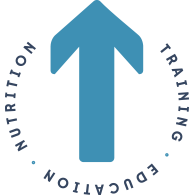WHAT KIND OF CARDIO IS BEST FOR ME?
First and foremost, it should be noted that cardio is a tool that the body will always adapt to. When trying to lose fat we want to be as efficient as possible (eating the most and doing as little as we can while also losing body fat). Click the button below to read more about efficiency and your health and fitness goals!
So what types of cardio should you be doing?
Let’s start with a definition of 3 different types you’ve probably heard of…
THE BREAKDOWN
LISS
Low Intensity Steady State (LISS) requires a low intensity at a consistent rate. Heart Rate is typically 50-60% of your maximum heart. You may be surprised to know that this type of cardio actually uses the highest amount of energy from fat. That said, as Coach Brad has mentioned in his blog post “technically lower-intensity exercise utilizes a higher percentage of fat to meet energy demands than high intensity exercise. But in no way does this mean that you will burn more total fat or have more total fat loss with lower intensity exercise. ”
Regardless of energy burn LISS cardio has quite a few other benefits. For instance- because LISS cardio is low intensity by nature, recovery is often easier as it puts less stress on the body. LISS (like walking) can also help to control glucose levels, lower cortisol levels (AKA stress), improve sleep, mental health, etc.
LISS is great for people trying to improve overall health or improve body composition, as well as manage their training volume and stressors. LISS also serves as a good “warm up” to your training session!
MISS
Medium or Moderate Intensity Steady State (MISS) is a step up from LISS as its target heart rate is typically 60-70% of your maximum. NOTE: You can predict your MAX HR by doing 220 minus your age. Example: 220-30 years old = predicted MAX hear rate of 190bpm.
When you think MISS, think running, cycling, swimming, rowing, stair-master, or using the elliptical at a pace that would allow you to get your heart rate up into Zone 2-3. You should still be able to “talk” at this pace - but not sing! As your heart rate increases, it will require more capacity from your lungs and will typically burn more calories than LISS.
While MISS isn't AS easy to recover from as LISS, it is still something that can be added to your fitness routine in moderation without causing chronic fatigue or under recovery.
Research shows moderate, Zone 2, cardio for 20-50 minutes 2-3x per week can have a huge impact on health and longevity with its recruitment of the mitochondria increasing available energy, improved metabolic flexibility, lower resting heart rate and blood pressure, and improve insulin resistance.
MISS may be a great addition for people with a fat loss goal, the cardio lovers, or people looking to create a deeper caloric deficit. There is a lot of variety when it comes to MISS so if you’re someone who gets “bored” with cardio, this may be a great way to add some variation to your training.
HIIT
High Intensity Interval Training (HIIT), unlike LISS and MISS, this is not a steady state form of cardio. HIIT is typically characterized by short bursts of all out activity followed by rest. Many people confuse HIIT with periods of higher and lower intensity or circuit style exercise. However, TRUE HIIT is something that you can NOT sustain for more than 1 minute at a time and you should need a full rest period to recover in preparation for the next interval. This can be done in a 1:1, 1:2, or more commonly 1:3 ratio. Heart rate will be 70-95% of your max heart rate, when in your high intensity interval.
Examples of HIIT: Sprints outside or on treadmill, bike sprints, stair sprints, etc.
Unlike LISS, when we engage in higher intensity cardio like HIIT, there is a shift from fat as your body’s primary fuel source to carbohydrates instead - since carbs are more readily available and faster to metabolize than fat.
That said, regardless of this increase in carbohydrate utilization, your body will continue to utilize fat for energy as well.
While HIIT training IS the hardest form of cardio to recover from, your body will need to utilize more energy to recover, in turn, causing your body to burn more fat AFTER exercise than it would after a bout of lower intensity exercise.
Keep in mind, because HIIT is harder to recover from, it may not be the best fit for those in a deficit, those trying to recover a menstrual cycle, minimize stress, etc.
However, HIIT may be a better choice for people looking to burn more calories in a shorter amount of time, reap some benefits of cardio without spending too much time on it, preserve muscle mass and metabolic power, and those looking for the adrenaline spike and release of dopamine.
*It should be noted that there is an incredible mental resilience and grit component to HIIT training. TRUE HIIT IS EXTREMELY DIFFICULT.
LASTLY…
It's important to note that cardio shouldn't be done at the expense of losing lean body mass. With increases in cardio, we often need increases in calories or sleep needs to help protect lean mass and to keep recovery and biofeedback in a good place.
The goal is to optimize overall health without sacrificing other aspects of it.
Believe it or not - There is now research that shows a strongcorrelation between loss of lean body mass and a rise in all cause mortality and muscle mass as an indicator for an increase in longevity. Do your cardio - but don't forget to prioritize strength training & adequate nutrition!
UNTIL NEXT TIME - COACH ALEX

